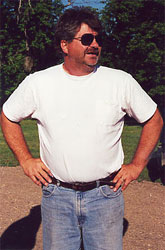An Eye Toward Technology for Boosting Profits
American farmers aren't hayseeds in bib overalls, says professor Steven Blank. About a quarter of all farmers have at least some college education. Among the operators of very large family farms, the figure is 35 percent. Many farmers live on the scientific edge of a major global industry.
 |    |  |
 |
 |
 |
 |  |  |
 |
Gary Wagner. Click to enlarge.
Photo: Stephanie Curtis |
 |
 |    |  |
Gary Wagner is next to his sugar beet field, running his eye over six farm houses visible in an arc from where he's standing.
"That guy works in Crookston. They no longer farm," Gary says.
Crookston, Minnesota is in the Red River Valley, nestled alongside the North Dakota border. "The guy there was farming about five years. He quit, runs a chemical business now ... selling to area farmers .... That farm there, somebody lives there, but they no longer farm .... So technically the only yard that you see right here that's actually farming is our stead here."
The same economic forces that are at work elsewhere in the U.S. are at play here in Minnesota: historically low prices, farmers squeezed out of business, no young people getting in, spouses working in town.
To counter those forces, the Wagner brothers—Gary, Wayne, and Daryl—are tilling the technological frontier. The second-generation farmers are leading practitioners of what's called "precision agriculture." The idea is to increase yield and lower cost by using technology to gather data and then use the information to boost productivity.
Wayne is sitting in an air-conditioned tractor with 90-foot booms. His hands rest on the steering wheel, but the computer housed in the cab is really in control. Wayne is spraying fungicide on a wheat field.
"That's the new technology that we're in, so we don't have to spend so much money," he says. "And we're a little more environmentally sensitive so that we only hit the spots we really need out here."
The Wagner equipment and their 4,200 acres of wheat, soybeans, sunflower seeds, and sugar beets are wired for data. They also rely on satellite-generated maps. The topographic images, with different hues of red, green, blue, and other colors, impart all kinds of information to Gary.
"Here is a satellite image of a field," he says, pointing to one of the maps. "What's this? Total nitrogen map. Used to spray whole field with fertilizer, but only 20 acres that needed to be treated .... To me, that's what this is all about. Less chemical in the environment. Less money being put out."
Gary says farmers from Russia, China, Australia, Germany, and elsewhere frequently visit the Wagners' high-tech farm. "[There is a] lot of interest," he says, "because they think they need to know this technology to keep up with the U.S."
Investing in new technologies is costly, but it creates profitable opportunities for family farmers like the Wagners'. Plus, the Wagners' are having fun working at the leading edge of agricultural know-how.

